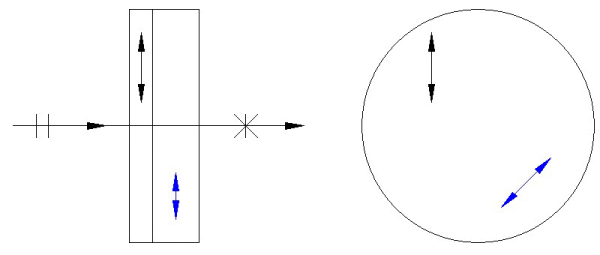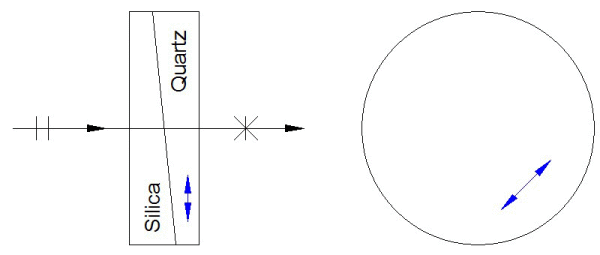It is sometimes necessary to ensure that a source is completely free of any preferred plane of polarization. An example of this is a sensitive spectrometer where varying degrees of polarization will lead to measurement errors. Of course, in nature almost all sources exhibit some degree of polarization; even thermal sources become polarized after reflection from a dielectric surface. Depolarizers are therefore essential items to have wherever a completely un-polarized source must be used.
There are two principle methods of producing depolarization but they operate in different manners. It is essential that the correct type is chosen based on whether the source is mono- or poly-chromatic.
Lyot Depolarizer
The Lyot depolarizer is assembled from two or more plates of birefringent material. In each plate the optic axis of the crystal lies in the plane of the plate and is orientated at 45° to the axis of the previous plate. The plates are manufactured in a geometric sequence of thicknesses, each plate being twice the thickness of the next thinnest plate. In the simplest case of two plates, one is just twice the thickness of the other. A three plate Lyot depolarizer requires one plate of thickness “t”, one of thickness “2.t” and one of thickness “4.t”.
Depolarization is obtained through the production of varying amounts of circular and elliptical polarization states at different wavelengths. The depolarization effect is poor for monochromatic light as even with a large number of plates in the stack there are only a limited number of polarization states produced. By contrast, a polychromatic source will produce an effectively infinite number of polarization states and thus depolarization is strong, even with just two plates.

Lyot depolarizer, available in Quartz, calcite etc.
Lyot depolarizers can be manufactured in just about any birefringent material, but most applications are covered by either quartz or calcite. Quartz is particularly suitable for applications extending into the ultra-violet and we can provide optically contacted components for minimum insertion loss. For applications where calcite is more suitable, we can provide either cemented or even air spaced components (but calcite is not suitable for optical contacting).
Wedge Depolarizer
The wedge depolarizer is the alternative form which should be used for monochromatic light sources. Again, a thick plate is manufactured in which the optical axis is in the plane of the plate. In use, the optical axis is aligned at 45° to the axis of the incoming polarized light and the thickness of the plate is varied in the plane of the incoming light (a wedge), thus producing a variable birefringence across the aperture of the plate. A second plate of index matching but non-birefringent material is added to the first plate to provide a compensation of the wedge angle, thus minimizing deviation of the beam but maintaining the depolarization. The most common combination is to use crystal quartz and fused silica, usually optically contacted together to enable applications into the ultra-violet.
Quartz-Silica Wedge Depolarizer
Leysop can provide these components in whatever diameter, thickness, number of sections you require (we have manufactured 22 section Lyot depolarizers for one especially critical application) and with or without AR coatings, as you prefer. Components can be provided mounted in protective rings or supplied bare. Please email us for your specific requirements.

